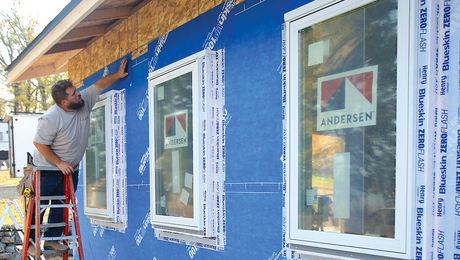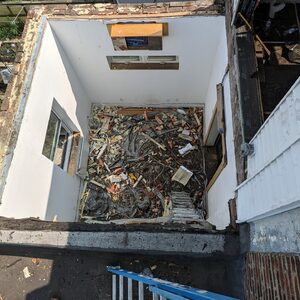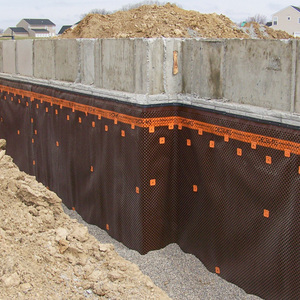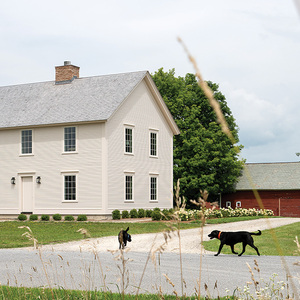Is there anyone who works in B.C. who is dealing with the new home warranty rules for exterior penetrations and envelope sealing? In particular I am looking for details on dryer vents, plug boxes, j – blocks, etc, for vinyl siding and fibre cement, and how to trim them to meet the requirements and also look good. I work in Fort St. John, so this is all new up here, but I thought someone in the lower mainland who has allready dealt with these issues might have some ideas. I would apprecite any help I can get.



















Replies
I went through the new home warranty program as a owner/builder two years ago and this was never mentioned. In fact the guy never even visited the job site. Is this something new?
For what it's worth, I'm just trimming out ours with tar paper, rough 1x4 cedar and flashing. Then Hardi pre-painted from Weiss. Is there something I'm missing?
Scott.
Always remember those first immortal words that Adam said to Eve, “You’d better stand back, I don’t know how big this thing’s going to get.”
It's new for us up here, but everyone says it's old news for the lower mainland. I'm not sure. Moisture has never been a problem up here since the air is so dry. We've never even heard of mold. Moisture from condensation yes, but not from rain getting in.
>>>Moisture from condensation yes, but not from rain getting in.Exactly; you want increasing permeability towards the exterior envelope. In your climate I would think your vapour barrier technique is the most important thing (as close to zero permeability there). As for the exterior, proper paper, flashing and high quality caulk are the ticket.Scott.Always remember those first immortal words that Adam said to Eve, “You’d better stand back, I don’t know how big this thing’s going to get.”
I tend to put a solid piece of 1.5" trim block on the wall, flash and bugscreen on top and run the rainscreen into it. The electricians should be using an exterior box with a built in rainscreen channel and if not they should at least have the box mounted out the 3/8 for the rainscreen. Peel and stick flash around everything and both national home warranty and st. paul accept it fine.
Thanks for the reply. The rainscreen is not required up here, but before now we have been using the white vinyl plug boxes, light outlets, and j - blocks, at least for vinyl siding. From what I understand, besides using peel and stick flashing around the penetration, we also need a drip cap flashing over the j - block. This defeats the purpose of a j block, because then you need to put a piece of j trim over the drip cap. For dryer vents we have been putting a drip cap on top of the metal dryer vent hood, and then trimming it with j trim, which is a lot more time consuming than using the store bought white vinyl dryer vents we used to use. Was the trim that y described for vinyl or hardi plank?
I'm going to give you a flashing method we use for vinyl siding that also works for Hardie siding. First though let me say that I live is the southern US and I have no idea of what the "new home warranty " program is that you refer to. BTW - what is it, some kind of government program beyond building codes? Can't you contact those people for the info?
Anyway... flashing method (somewhat simplified for illustration purposes): OK, let's say you have a framed house with house wrap, etc all installed but no siding... Electrician drills a hole through the exterior wall and hangs his wire out for an outlet or sconce light. You, (or your siders) deal with it like this: Take a piece of black 6 mil polyethylene plastic 1' x 2'. (the dreaded imperial measurements (-: ) . Poke a hole in the plastic about 8" from the top and centered left to right and slip it over the wire, - the plastic is oriented with the 1' side horizontal and the 2' side vertical. Now cut a 1' slit in the housewrap near the top of the plastic and slip the plastic up under the housewrap and tape the slit back closed with house wrap tape. Install J-block as normal. Now, as you run the siding up the house, the piece that ends just below the j-block is installed behind the plastic flashing. The next piece of siding above that has the hole cut for the J-block and is installed on top of the flashing plastic. Once the area is all sided, the extra plastic that is hanging out is cut off with a razor knife.
see attached pic. This same method works for a pipe (hose bib), electrical service meter box, or whatever.
Just out of curiosity, why do you use plastic instead of a piece of housewrap? I would think plastic might present some problems with regard to condensation.
Flashings need to be waterproof in order to work. The idea with flashings is that you install them where you know water will try to enter the exterior cladding and direct the water outward.
To take the other point of view, I guess that would mean that window flashings, roof flashings, etc should be made out of house wrap. :-)
If you were worried about it you could use smaller pieces of plastic - I used the 1'x2' piece just as an illustration in my "simplified example". The idea is though that you need to make sure that it is big enough to where there is enough of a piece hanging down to come out of the lap siding. BTW - vinyl siding has little drain holes in the bottom edge which helps this whole thing work.
Thinking more about it, with modern buildings built the way they are today, more drying of the inside of wall assemblies takes place to the inside than to the outside - I'm talking heating and mixed climates here. What with almost all modern sheathing materials having a permeability of 1 or less (OSB, rigid foam, and even thermoply) not much moisture vapor is going to travel through the wall assembly inside to out. Further any condensation in a wall assembly will tend to occur on a surface where you have the greatest temperature difference from one side to another - which in a properly insulated wall will not be at the exterior. The crux of the matter is to prevent moisture from entering the wall assembly to start with - then the drying of wall assemblies becomes less of an issue. Back in the days when houses were loose this wasn't so much of an issue as the wind blew right through walls a dried them. Just to further illustrate the drying point, here, the use of real vapor barriers on the interior of the wall assemble has fallen out of favor - builders used to use plastic - now 90% use just the craft paper facing on insulation which is more just to hold the insulation in place and a is a joke of a VB, with only a few hold-outs still using polyethylene - granted this may not work in other climates.
My impression is that poly as a vapor barrier is a very cold climate application, like Canada or North Dakota. Any you have to really seal it, including at the floor, not just the seams and around boxes.I live in old houses. Another layer of brick is our idea of insulation.
If you don't like the poly idea you can always do the same details with roofing paper.
It seems to me that the best pick is the material the house is wrapped in, whether that is tyvek or building paper or what have you. Seem like staying with the same product is a can't go wrong proposition.
Thanks for the reply. Don't worry about imperial measurements that's all we use here when it comes to building. You're flashing method sounds great I think I might use it. I'm just wondering if it will fly with the home warranty guys. New home warranty is a program that came about after a bunch of condos in Vancouver started leaking water because of lousy builders. The government made it mandatory to warranty houses for ten years, and made a bunch of guidelines that are seperate from the building code. Not a bad idea if you could get a clear cut rule for little details like we are talking about.
We use the same method on the bottom of windows. One of the reason it's a great method (besides the fact that it works) is because it's cheap!
what the "new home warranty " program is that you refer to
My understanding is that it's a government program that is supposed to "safety net" homeowners getting construction work done.
From watching Holmes on Homes, there appear to be sufficient gaps in that net to make money selling a tv series about "making it right" for those who have fallen between the cracks.Occupational hazard of my occupation not being around (sorry Bubba)
It's a little more complicated than that, speaking as a family that took a $60K ####-kicking from this leaky condo issue. In one sentence, the crisis was a perfect storm of high building investment, poor design practice, high consumer demand, over-extended inspectors, labour shortage, and greed. After all the dust settled (and there is still dust settling) was a government program that made contractors and owner/builders responsible for the integrity of the building for a period of time before they could sell the property.Personally I don't have a problem with the program. In fact I like it, because I'm trying to build a quality house, not trying flip a lousy piece of work to make a quick buck.Scott.Always remember those first immortal words that Adam said to Eve, “You’d better stand back, I don’t know how big this thing’s going to get.”
Edited 1/19/2008 1:19 am by Scott
>> Personally I don't have a problem with the program. In fact I like it, because I'm trying to build a quality house, not trying flip a lousy piece of work to make a quick buck. <<
EXACTLY!
Sometimes we whine about government mandated requirements (codes) but if all builders are required to deliver the same minimums, it doesn't allow the uneducated or uncaring builder to undercut builders who do care. Case in point: The energy portion of the new building code that just came into full force here requires the use of Low-E windows. I'm thrilled, because now I can put a good product into every house I build and not have to worry about the builder across the street being able to produce almost exactly the same house for $250 less, even though probably 90% of home buyers would be like "Low-e windows?" with a puzzled look on their face, and then "I don't think I need that", or maybe "Low-E? I think I've heard of that."...
BTW - is that program nation wide or only in certain Providences?
Edited 1/19/2008 7:36 am ET by Matt
>>>BTW - is that program nation wide or only in certain Providences?The only province I know about is BC, but there may be others.Scott.Always remember those first immortal words that Adam said to Eve, “You’d better stand back, I don’t know how big this thing’s going to get.”
"a perfect storm of high building investment, poor design practice, high consumer demand, over-extended inspectors, labour shortage, and greed."
Yes, don't forget the greed. Without the greed there wouldn't have been any Condo Crisis.
http://www.chbavictoria.com/center/members/Rainscreen/ACCEPTED%20RAINSCREEN%20DETAILS-4%20(July%202007).pdf
This has various rainscreen details which I hope are of some use.
Thanks for the info. Much appreciated.
Now, that's a great detail page. Thanks for providing it. There was a big rush on about a year ago to get permits stamped b4 the new rainscreen rules went into effect. The additional spacing, etc. was going to add a few $$ to the cost of building, so the developers wanted to get their approvals done under the wire. The new regs don't apply beyond the lower mainland in British Columbia, but it would make good sense to have it effect for all of BC.
Incidentally, can you tell me what the purpose of the 2 mm gap in the sheathing is for? It looks like it must be a pain in the azz to build with a gap like that or is it easier than it looks? Thanks again.=================================================================
If your parents never had children, chances are you won't, either.
For all the talk about rainscreen, it's remarkably hard to find acceptable details. It's like no one wants to take responsibility in case down the road things don't turn out.
The gap is supposed to allow any moisture that makes its way into the wall cavity to dry to the outside. Where there is no joint in the sheathing, such as under windows, they want holes drilled to vent the stud space.
Its easiest when you are sheath before standing the walls. Using pre-cut studs you end up with an 8'-1" wall. Running the sheets flush with the top and bottom plates gives you a 1" gap.
The gap and holes are annoying when you are siding, especially with an nailer. Sometimes they are exactly where you want to nail, sometimes you think you have nailed it and hit only air.
Got it. Thanks for the response. It just seems that with a vapour barrier on the warm side it'd be pretty tough for moist air to make its way through.
Cheers,
KenYou live and learn. At any rate, you live.